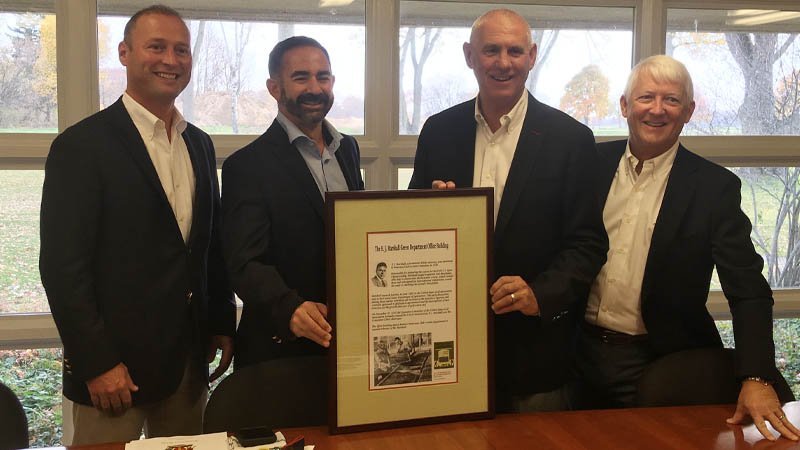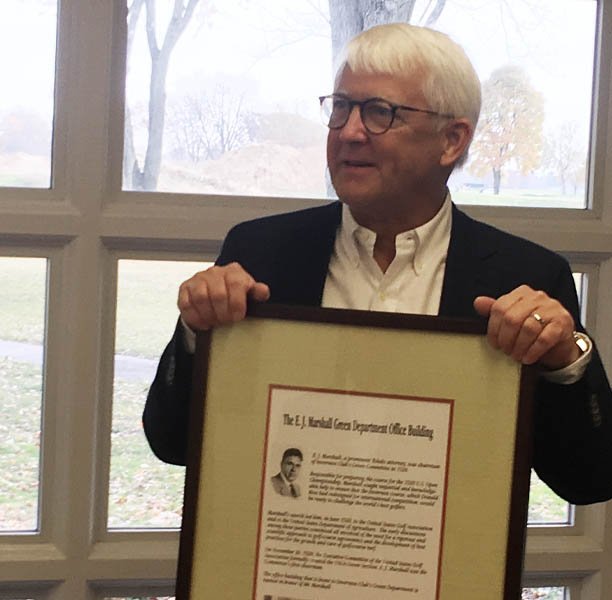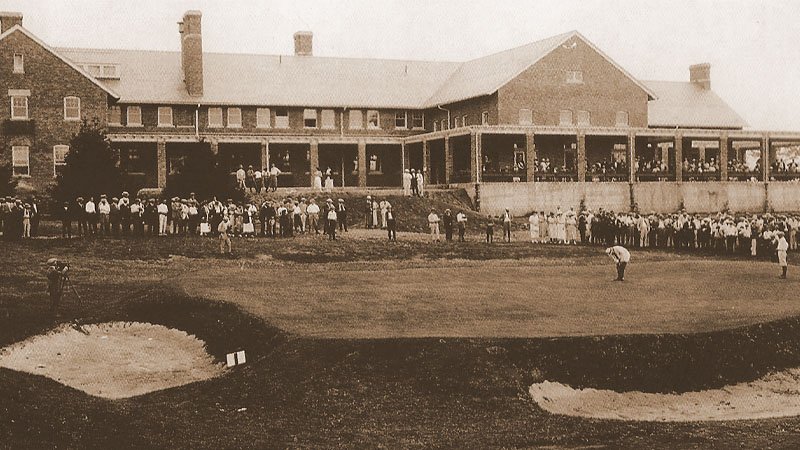
It is doubtful that E.J. Marshall could foresee the long-range impact of his decision when the Inverness Club's green committee chairman sought help for an undiagnosed issue on the greens in advance of the 1920 U.S. Open.
About two months before the Open, Marshall and greenkeeper William J. Rockefeller, a distant cousin to Standard Oil magnate J.D. Rockefeller, began noticing brown patches of dead or dying turn on the greens at the course in Toledo, Ohio, that architect Donald Ross called one of his favorites.
 It was to be the first of four U.S. Opens held at the course that Ross began redesigning in 1916, and with the likes of such seasoned pros as Harry Vardon and Ted Ray on their way, everything had to be just right. Marshall called in experts from the U.S. Golf Association and the U.S. Department of Agriculture for help. That collection of agronomists assembled to help revive the greens for the 1920 Open eventually led to the formation of the USGA Green Section on Nov. 30 of that year. Since then, the Green Section has played a key role in turfgrass research, education, course consulting services and supporting agronomic decision making for championship events.
It was to be the first of four U.S. Opens held at the course that Ross began redesigning in 1916, and with the likes of such seasoned pros as Harry Vardon and Ted Ray on their way, everything had to be just right. Marshall called in experts from the U.S. Golf Association and the U.S. Department of Agriculture for help. That collection of agronomists assembled to help revive the greens for the 1920 Open eventually led to the formation of the USGA Green Section on Nov. 30 of that year. Since then, the Green Section has played a key role in turfgrass research, education, course consulting services and supporting agronomic decision making for championship events.
Recently, members of the club marked the centennial of the Green Section and the role Inverness played in helping found it. As part of the celebration, the membership at Inverness presented current superintendent John Zimmers with a plaque to commemorate the club's place in the annals of agronomic research. That plaque now hangs in the turf maintenance facility at Inverness that is named in Marshall's honor.
"As he looked for information on turfgrass, he really didn't find much and ended up approaching the USGA and the USDA," said Inverness past president Jerry Lemieux. "We have a whole bunch of minutes and correspondence back and forth between Marshall and those organizations, and out of that was formed 100 years ago at the end of this month the USGA Green Section that for the last 100 years has made strides and supported turf research. If you play golf anywhere in the world, you've been touched by the USGA Green Section. We thought the anniversary was an appropriate time to dedicate this building as the E.J. Marshall Green Department Office Building."
As a leader in the formation of the Green Section, Inverness enjoys a history of firsts.
The 1920 was Vardon's last, but it was the first for the great Bobby Jones, who later founded Augusta National Golf Club and The Masters Tournament. It also was the first for Gene Sarazen and Tommy Armour. Inverness also is where an amateur named Jack Nicklaus played in his first U.S. Open in 1957. Nicklaus went 80-80—160 and missed the cut before eventually going on to win four U.S. Open championships and 14 other major titles throughout his career.
"A lot of firsts have happened here," said Lemieux, who has served as a rules official in more than 60 USGA events.
"The genesis of the Green Section that means so much to so many people around the world started here. Think of the worldwide impact it has and all of it out of frustration from a guy losing his greens ahead of the U.S. Open and trying to figure out what to do."

Until 1920, competing pros were not allowed access to a club's locker room facilities. That changed with the first Open played at Inverness. To show their appreciation, the competitors presented the club with a grandfather cathedral clock that still marks time at Inverness today. That air of welcome is a legacy that remains a bedrock on which Inverness rests today.
"The way I view it, we are a club for the people," said Inverness green committee chairman Matt Douglas. "We appreciate the game of golf and respect the history and tradition. We know who we are, and we know what an asset we have out there.
"We enjoy playing here day in and day out. That being said, we enjoy hosting people here. It is a privilege to host people here and show off what we think is one of the top national golf courses. We as a club embrace the USGA Green Section, and we are honored to be called the home for it."
Much about the game has changed since 1920, and the Green Section has been there every step of the way, helping educate superintendents on changing conditions and turf management protocols.
"For me, this is quite an honor," said Zimmers. "When you think about the Green Section, people miss a lot of things. It's not just about turf; it's about water quality, it's about proper drainage, it's about tree removal, it's about sun and shade and different varieties of grass. It has changed so much over the years.
"It has changed how golf is viewed and our responsibilities for inputs and fertilizers and chemistries, and their relationships with our suppliers who give us better and safer products, the research with universities. Their influence is felt all over the country and all over the world."
Throughout its 100-plus year history, Inverness has been the site of four U.S. Open Championships (1920, 1931, 1957, 1979) and two PGA Championships (1986, 1993).
The club, named for the town in Scotland of the same name, will be on the big stage again in 2021 when it is the host site of the Solheim Cup.
The influence of the Green Section is evident still today at Inverness, where architect Andrew Green completed a restoration in 2017 that brought back many of Ross's design elements that had been lost through the years.
A lot of firsts have happened here. . . . The genesis of the Green Section that means so much to so many people around the world started here. Think of the worldwide impact it has and all of it out of frustration from a guy losing his greens ahead of the U.S. Open and trying to figure out what to do.
The restoration coupled with Zimmers' reputation for being tournament ready every day has made the revival project a smash hit with members.
"We put a long-term plan in place. We wanted to return Inverness to the Donald Ross golf course that it was intended to be," Douglas said. "We stayed steadfast in that mission, and we made the membership aware of that, and they embraced that. I can tell you that our membership is absolutely blown away by the strides we have made."
Everything was put to the test in June when the LPGA asked to host a tournament at Inverness in late July that ran concurrently with the Marathon Classic at Highland Meadows in nearby Sylvania. The goal of the LPGA, which had been on site regularly because of the upcoming Solheim Cup, was to create a bubble in the early days of the pandemic to limit contact and exposure for its players by kicking off its season with two tournaments in the same market. That gave Zimmers, assistants Carlton Henry and Ryan Kaczor and the rest of the team just six weeks to go from zero to 60.
"They came and knocked on the door, and we were ready," Douglas said. "A lot of that is because of JZ and who he is and the crew he has developed here, and a lot of that is because of the USGA Green Section."
By most accounts, the event went off without a hitch. In fact, the only one who knit picked it in anyway was Zimmers.
"Tournaments are all different, and this one was new for me," he said. "I've been blessed to be part of a lot of tournaments, but this was my first LPGA event, so it was new getting used to how they do things.
"The good thing is it's exposure, but with exposure, you put yourself out there for everyone to see. That week we had record heat, and we were just working through the mental stress of Covid. The play was delayed when a fog bowl rolled in out of nowhere and just sat on the golf course. We had a good week, but the weather was tough."
Deep down, the LPGA knew if there was a place within shouting distance of Highland Meadows that could be ready for the LPGA field and a TV audience at the drop of a hat, it was Inverness.
"Logistically, that is not easy to get a golf course ready that quickly," said Green Section agronomist Zach Nicoludis. "If you were going to ask me to give you five superintendents who at the drop of a hat could host a PGA Tour event, LPGA event or a USGA championship, I'm pretty sure John's name would be on that list every time."
Being ready for anybody and everybody all the time is just part of being a golf course "for the people."

